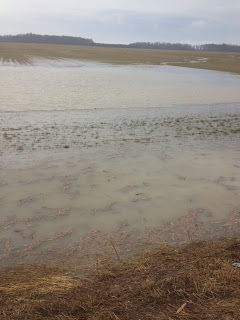Other than that little bit of progress field work has been a no go, but that will change soon.
I was asked on the weekend if I had taken any soil temperatures. I said no because when the ground is wet, it doesn't matter what the temperature is. Agronomists often write about and fuss over soil temperatures. It sometimes is a factor affecting the outcome of early planting corn and soybeans.
Once the calendar switches to May I don't care about soil temperatures any more. If the ground is fit, plant. Simple. Put the temperature probe away, hopefully in a place that you can remember where it is come next April.
The big money men are jittery about planting progress in the US. The chart below has them spooked.
The prime planting window is here and very few acres are in the ground. We know how quickly that can change.
A blog post by Darrel Good at www.farms.com/ puts a statistical twist to the number of days suitable for field work and planting progress on a typical day in Illinois. The basic premise is that while farmers can plant many more acres in a day thanks to machinery technology than they could in the 70's, the number of total acres per day planted has not increased very much. Sure farmers can plant more but there are fewer farmers. The net result is less acres per day than what you might think. You can read the mind numbing numbers at the link below
http://www.farms.com/ExpertsCommentary/darrel-good-how-much-of-the-2013-corn-crop-will-be-planted-late-61957.aspx
Hopefully next week we will be too busy to blog.
http://www.farms.com/ExpertsCommentary/darrel-good-how-much-of-the-2013-corn-crop-will-be-planted-late-61957.aspx
Hopefully next week we will be too busy to blog.


.jpg)












